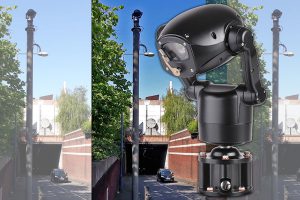
Tunnel vision: Cubic and Transport for London choose ruggedised Predator PTZ cameras for traffic safety monitoring at Limehouse Link Tunnel
When Cubic Transportation Systems and Transport for London identified that the Limehouse Link Tunnel in London’s East End would benefit from an upgraded traffic safety monitoring system, they opted for the advantages offered by Predator Ultra HD cameras from 360 Vision Technology.
Let’s face it: traffic tunnels are cool. Perhaps it’s their artificially lit, subterranean nature, coupled with the unspoken thrill of passing smoothly, at high speed, through an entirely manmade structure. Maybe it’s their place in Hollywood’s celluloid iconography, light tracing the contours of our protagonist’s face as they race toward, or away from, one crisis or another.
Maybe it’s the way tunnels are the embodiment of human ingenuity made solid, engineering as pure solution: let’s get from A to B as efficiently as possible, and if that means going under or through whatever gets in our way, well, that’s what we’re going to do.
Whatever it is, tunnels are irrefutably cool.
And the Limehouse Link Tunnel is one of London’s coolest. Opened for use in 1993, it stretches for a little over a mile under London’s East End. Travelling along the A1203 from The Highway to Canary Wharf, it takes vehicles under the Limehouse Basin, Limekiln Dock and Dundee Wharf, then curves north-east under Westferry Road to emerge near the West India Quay DLR station. It’s apt that the entrances and exits to the tunnel are known as ‘portals’: the Limehouse Link Tunnel transforms commuters into virtual time travellers, entering from the historic, fabled streets of the East End and emerging, blinking, into the hyper-modern glass and steel-emblazoned environs of the reclaimed Canary Wharf.
Those portals are adorned with distinctive artworks, glimpsed by the passengers in the thousands of vehicles which traverse the length of the tunnel in both directions every day : on the western end is Zadok Ben-David’s circle of silhouettes, ‘Restless Dream’, while the eastern portal features an untitled abstract by Nigel Hall.
Underground safety
For a massively busy tunnel like the Limehouse Link, safety is paramount. Speed limits are set at 30mph, and Transport for London traffic management teams constantly monitor the live video feeds from cameras sited strategically along its course to ensure traffic flows smoothly and any incidents can be acted upon swiftly and safely.
The camera system in the Limehouse Link Tunnel is maintained by Cubic Transportation Systems. Award-winning Cubic has worked with TfL for many years, helping to deliver the famed Oyster payment system and continually working to reinvent the way integrated technology is used in managing traffic and public transport across London.
Recently, it was decided that the existing cameras in the Limehouse Link Tunnel were in need of an upgrade. Cubic Senior Field Services Manager Neil Ashford explains.
“The older cameras that were being used in the tunnel had become obsolete,” he says. “This was due to camera part obsolescence fault levels increasing, and critical areas of tunnel coverage becoming more challenging to maintain with adequate CCTV coverage. Roadside cameras need to be tough and reliable, so we needed a ruggedised model that could withstand the rigours of constant use in that environment.”
Cubic had used Predator Ultra HD cameras from UK manufacturer 360 Vision Technology on an earlier tunnel project, and this experience convinced Neil Ashford, and Cubic, that they’d be up to the task.
The Predator PTZ camera range is a high performance, fully featured range of ruggedised pan-tilt-zoom cameras, designed and manufactured in the UK. The distinctive Predator range comes with multiple protocols as standard, allowing quick and simple integration with DVRs, matrices, and IP VMS systems. The Predator Ultra cameras provide HD images, 30x optical zoom, and extremely low light operation.
Technically adept
One challenge the Limehouse Link Tunnel upgrade project faced was transmission: how best to ensure the 1080p HD images captured by the cameras could be sent to the TfL control centres. Thankfully, in addition to its direct IP connection options, the Predator cameras feature a 12-pin connection in the base of each unit, allowing the new replacement cameras to be connected directly to the existing cable infrastructure of the old camera system. This feature alone saved significant time and installation costs.
“Being able to install the new Predator cameras without making any changes to the local camera infrastructure was a great advantage in reducing installation time and cost of the project,”,” Neil Ashford says. “Another of the key factors in choosing to use the Predators was the relationship we have with the manufacturer. They are the true expert on the camera, and working directly with them can help us to quickly and efficiently solve any issues that might arise.
“Being UK-based is part of it. But the crucial thing is access to knowledgeable staff. I have a highly technical team of engineers, and thankfully 360 Vision have highly technical staff who listen to and address any problems that we find with a camera. It’s a very good working relationship. In fact, I would go as far as to say that they are the best supplier I have ever worked with. I wouldn’t hesitate to recommend them on future projects.”
Proactive monitoring
A total of 56 Predator Ultra 30:1 HD cameras are now in active use in the Limehouse Link Tunnel. The cameras are monitored at a variety of locations, including the primary Transport for London Network Management Control Centre (NMCC).
The complex, 24-hour NMCC operation integrates previously separate control departments into one central hub, providing a more efficient and linked-up approach to roads management. It’s part of the ‘Vision Zero’ approach to traffic and transport strategy, with a long-term aim of eliminating all deaths and serious injuries from London’s streets.
Operators look out not just for active incidents such as accidents and collisions, but for anything that has the potential to cause one, including loose manhole covers or potholes. When one of these situations is spotted, the Predator camera is zoomed in to confirm its cause and help to diagnose a swift solution, which could include closing the tunnel for rapid repairs.
Both Cubic and TfL have been extremely impressed with the performance of the Predators.
“TfL has received the new cameras very well,” Neil Ashford says. “Image quality is remarkably high, and it allows the operations team to get the pictures that they need to assess and respond to incidents as they occur. We’re very satisfied, so much so that further use of the Predator camera will be at the forefront of future projects.”
Jason Wyatt, National Account Manager at 360 Vision Technology, says the company is proud to work with Cubic on key projects like this one.
“We’re extremely happy to be able to provide our ruggedised Predator cameras for crucial traffic projects such as monitoring the Limehouse Link Tunnel,” he says. “Working with Cubic and TfL is a real vote of confidence not just in our products, but also in the technical knowledge and skillsets of our full 360 Vision Technology team.”
